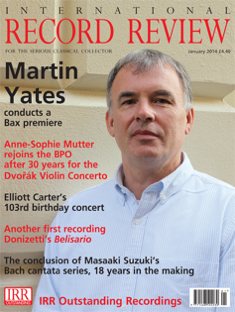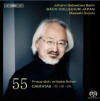Texte paru dans: / Appeared in:
*

International Record Review - (01//2014)
Pour
s'abonner / Subscription information
BIS
BIS2031

7318599920313 (ID355)
It’s taken 18 years, and remarkable dedication and consistency from both performers and record company, but finally Masaaki Suzuki and Bach Collegium Japan have reached Volume 55, the last volume, of their complete Bach Cantata series for BIS Records. In his Foreword to Volume 1 — completed on the 5Oth anniversary of VJ-Day in August 1995 — Suzuki was excited and passionate about the prospect which lay ahead. He patiently explained that although some people may be surprised that the Japanese should think of performing the music of Bach, ‘what is most important in infusing a Bach cantata score with real life in performance is a deep insight into the fundamental religious message each work caries’ . As a committed Christian himself, Suzuki felt strongly that ‘the two hundred years separating the time of Bach from my own day can be of little account ... since the God in whose service Bach laboured and the God I worship are one and the same . . . We are fellows in faith. ‘ He ended with the worthy aspiration that this cantata series ‘may demonstrate that Bach’s music contains a message which can touch the human heart, regardless of nationality or cultural tradition’.
It is a tribute to the power of Suzuki’s vision that, two decades later, he and Bach Collegium Japan are now considered major players on the international Bach stage , and have gone on to record many of Bach’s other major works — both vocal and instrumental, sacred and secular. In the Foreword to the final volume of the cantata series, Suzuki reflects that the ‘missionary’ zeal of his initial introduction now makes him ‘blush inwardly’, but that the journey through Bach’s cantatas has proved to be every bit as challenging and joyful as anticipated. The constant routine of minutely examining each work, getting to know it, performing it, and then finally recording it, was ‘like enjoying a splendid gourmet meal knowing we soon would have to eat again’ . It may sometimes have felt like ‘an endless but now that they’ve reached’ BCJ all agreed they will never stop performing the cantatas. We can only hope that they are able to tour more extensively than they have had the lime or opportunity for in the past.
My interest in this series was first sparked by the positively evangelical reviews of the late (and much missed) Peter Branscombe. On the strength of his recommendations in these pages I went out and bought many of the early volumes of the series myself. The first disc I received for review was Volume 14, which arrived in 2001, and reading back through my copy I can see that I was particularly impressed by Suzuki’s decision to reduce the size of his choir — from 20 in Volume 1, later slimming to 16, and with Volume 14 settling down to the three-to-a-part line-up (with each section led by one of the soloists) — which has remained fairly standard ever since. In my review of Volume 15 I began to see the wisdom of Suzuki’s more measured tempos, his striving for transparency of texture and general avoidance of the extrovert gestures and theatricality of some of his competitors — not least his teacher, Ton Koopman. But over the next few years, I did express a few reservations about Suzuki’s soprano soloists. In the early days he often used home-grown singers like Midori Suzuki and Yukari Nonoshita, whose simple, clean tone and fairly straightforward approach to the music was not always judged to be as nuanced and text-aware as one might have liked. I rather regret, now, that these singers have faded away and that Suzuki went on to employ a succession of more mainstream European sopranos. But his bass anchor Peter Kooij has remained — hardly ever interrupted — all the way to Volume 55, alongside favourite tenor Gerd Türk and countertenor Robin Blaze.
As for the players: it’s no exaggeration to claim that this cantata series established and formed a focal point for the development of Japanese period-instrument performance. What in 1995 was a fairly rough-and-ready assortment of players, some of whom had been lucky enough to study in Amsterdam like Suzuki himself, has gradually evolved into a nucleus of technically proficient and expressive string, wind and brass players. Interestingly, for Volume 55 the brass section has been imported from Europe — perhaps because of trumpeter François Madeuf’s ability to do without modern tuning vent holes (the latest refinement in period brass playing).
One of the problems with final volumes in long-running series is that, unless you plan carefully, it can all be a bit of an anti-climax. But not here, though admittedly, we do meet Bach at the tail-end of his enthusiasm for church music. By the 1740s he had long been recycling older music freshened up with new texts. Lobe den Herrn, BWV69 was performed for the inauguration of the new Leipzig Town Council in 1748 and was based on a cantata first heard in 172 3, with a few tweaks to the recitatives and scoring. Freue dich, BWV3O started life in 1737 as a secular cantata welcoming Count Hennicke to his new estate; Bach commissioned a new text to suit church use, added a chorale, new recitatives, and — sadly — removed the splendid trumpet parts (for practical reasons). Finally, Volume 55 ends not with a cantata at all but with the splendid Gloria in excelsis Deo , BWV 191 based on three movements familiar from the Mass in B minor, and possibly intended for performance in Leipzig on Christmas Day 1745 to mark the Treaty of Dresden.
One of the most subtle but telling changes in the approach of the singers of Bach Collegium Japan since 1995 has been their increasing confidence with German. At the very outset, Suzuki recognized that not only the pronunciation of the language itself but also the sense of musical phrasing and articulation which emerge from it are all alien to the Japanese musical tradition. Over 55 volumes lessons have audibly been learned, and listening to Volume 55, we can hear how Suzuki’s style of choral singing has fed back into the European Baroque mainstream, offering a new and more subtle alternative to all those dynamic, driven British and German choirs who paint Bach so boldly. There are times when the Monteverdi Choir’s overt, firebrand Bach provides exactly the level of excitement one craves. But in his subtle, modest hands, Suzuki shows how ‘less’ is so often ‘more’. In the opening chorus of Lobe den Herrn Suzuki’s singers project the text and musical argument with glorious rhetorical understanding, without letting the sopranos dominate the choral texture, or the choir dominate the orchestra. Certainly, the choir here is more forward and forthright than in the early volumes, but beautifully balanced, and never attention-seeking or overtly theatrical. Conveying the message of the text and maintaining clarity of texture guide Suzuki in everything he does.
There’s a good spread of mood and emotional contrast in the arias of Volume 55, with a slight bias in the secular direction thanks to the worldly origins of Freue dich . In ‘Eilt, ihr Stunden’ soprano Hana Blažiková produces a rapturously pure and concentrated tone which avoids the white, depersonalized timbre to which she has sometimes fallen prey of late. She shapes her decorative phrases with a joyous swing in her step, and Suzuki coaxes out the music’s secret allegiance to the gigue. In Lobe den Herrn the catchy bass aria ‘Mein Erlöser’ treads the jerkier steps of the Polish mazurka, and Kooij copes masterfully with the oddly irregular syllabic flow of the text — which could easily wrong-foot a lesser man. His long sustained notes, which punctuate the piece, are simply exquisite in their concentration of unwavering tone ... just warmed by the merest whisper of vibrato at their tail ends. Blaze’s voice has changed quite dramatically during the course of this series: from piping Anglican purity to the warmer, more worldly sound he produces here. He has an aria in each cantata, and in both he applies a very slow vibrato to his longer notes quite unlike that produced by most other countertenors. Just occasionally, in ‘Kommt, ihr angefochten Sünder’ , there’s a tonal emphasis on certain notes in his mid— to upper register which is not quite as smoothly integrated as it might once have been.
Musically , Volume 55 offers a sumptuous climax to the
series, with some of Bach’s finest choruses set off by blazing writing for
three trumpets, timpani and some unusually colourful writing for three
oboes, flutes and strings. The Gloria finds the members of Bach
Collegium Japan at the top of their game: enjoying some full-throated
singing, alive to the ever-changing instrumental colours and contrapuntal
argument, but with a measured tempo in the opening chorus which conveys its
joy with spacious dignity. The final chorus is a miracle: somehow Suzuki and
his singers convince us that the new ‘ Sicut erat in principio’ text which
Bach brutally imposed on the familiar ‘ Cum sancto spirito’ chorus actually
works in practice . It’s utterly thrilling.
Fermer la fenêtre/Close window
Cliquez l'un ou l'autre
bouton pour découvrir bien d'autres critiques de CD
Click either button for many other reviews


